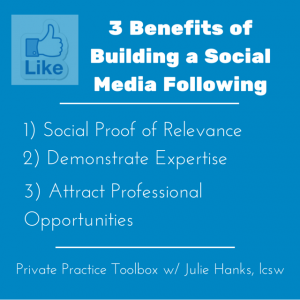 In this guest post, Miranda Palmer LMFT and Kelly Higdon share eight ways to thrive in the current private practice climate.
The process of building a successful private practice has changed considerably over the last twenty years. Most therapists we speak with who have been in practice for a few decades started by getting their credentials from an insurance companies. Reimbursement rates were relatively high for the cost of living from the 80s into the early 90s. Things flowed. Maybe they had a listing in the phone book, but back then there was no need for websites, Facebook pages, or Twitter accounts!
In this guest post, Miranda Palmer LMFT and Kelly Higdon share eight ways to thrive in the current private practice climate.
The process of building a successful private practice has changed considerably over the last twenty years. Most therapists we speak with who have been in practice for a few decades started by getting their credentials from an insurance companies. Reimbursement rates were relatively high for the cost of living from the 80s into the early 90s. Things flowed. Maybe they had a listing in the phone book, but back then there was no need for websites, Facebook pages, or Twitter accounts!
Fast forward to now: the financial picture for therapists in private practice has drastically changed, as we are in a time of low or stagnate reimbursement rates combined with an increase in cost of doing business and living.
The old model is simply that, old. It doesn’t work for today, and thus we find experienced therapists with a full practice that isn’t profitable enough to prepare for retirement, and new therapists often feel lost when they ask their mentors for direction and get answers that don’t resonate with the current economy.
We want to simplify the steps required for launching and successfully running a private practice in 2014. Whether you are starting out fresh, have moved to a new city, or need to make some significant changes in your business foundation, these steps will help you get things on track!
1) Develop a clear vision of your life
We tell our clients to do this regularly. We help them reassess and ask them to be accountable for the choices they make that lead them toward or away from that vision becoming a reality. This is your road map. When you begin with a plan for your life, your business can be formed to support that plan. So before you come up with an awesome group therapy curriculum or some other great idea, write down a super clear vision for your work AND home life.
2) Take that vision and break it down into pieces
Having a simple vision, with no basis in reality, can be difficult. How much money do you need to make that vision come to life? What would it take for you to go home at that time each day? Are you preparing for quarterly taxes? Are you realistic about how many clients you can see regularly while avoiding burnout? Are you leaving time for networking and marketing your practice? Leaving time for going to trainings? For being sick? Are you leaving enough time to return client phone calls and be available for crisis situations?
This is where people can get stuck in magical math. If I see 20 clients at $100/hr, that is $2,000 per week for 50 weeks – that’s six figures! YET there are expenses, taxes, real life stuff that happens. Be honest with your capabilities and your needs. Also, be open to the idea of reaching your goals in different ways. You might discover that face-to-face sessions is only a part of the plan. Now go crunch numbers, write down the schedule, and look at the specific pieces that are needed to fully form your vision.
3) Develop a business plan based on your vision and those realistic pieces
Every therapist in private practice needs a written business plan. He/she must know exactly how the fee was developed, how many sliding or pro bono slots there are, how much money is put toward retirement, etc. There is also a bit of research to be done here. Surprised? Sure, people need mental health services, but who and where are they, and what are the holes in the market in your area? Have a clear idea of who you want serve and how you plan to serve them. Write it down; be accountable to yourself.
4) Develop a sustainable plan to let your community know who you are
Notice I didn’t say develop a sustainable plan to let people know your business exists. People decide to work with therapists they know, like, and trust. Being authentic in how you present your private practice to the public doesn’t have to mean complete self-disclosure. Maintain professional boundaries, but don’t be afraid to let your personality shine!
The beauty of our current world is that people can advocate for themselves by choosing a provider who they believe is prepared to help them heal. If a potential client doesn’t get a chance to hear your “voice” and how you practice, how can he/she determine if you are a good fit? How hard is it for you to choose a therapist for yourself? Can you imagine how much more difficult it would be without an advanced degree and a deep knowledge of psychological theory? Make sure to clearly communicate what unique things you can offer as a therapist.
Be aware of your insecurities and how you demonstrate those to the world. Now is the time to believe in yourself and honestly take stock in what you bring to the table. It is not prideful to share your craft with others. It is necessary in order to build relationships and instill hope in members of your community.
5) Develop and maintain clear business boundaries
Your business is your service to your clients. You may think that the things you are doing on a daily basis are serving your clients, but you need to be honest with yourself. If your business is struggling, it will impact your clinical work. What would happen if your clients talked to one another? Do more assertive clients pay a different fee than passive clients? Do clients with poor money management skills pay less than a client who has better budgeting skills?
Stick to your plan. Go back, and if you start to waver, remember #1 – why you are doing this in the first place? What is the life you are seeking to create? Who are the clients you are seeking to transform? When you break those boundaries, you are holding yourself back from the dreams you have for yourself and from helping your community in a profound way.
6) Streamline your business processes
The best way to do great clinical work is to free yourself up to do great clinical work. Whether this means transitioning to a paperless office to reduce late cancellations or no shows and decrease unpaid balances, or outsourcing your insurance billing so you never have to sit on hold with insurance companies again, find a way to make the business process work efficiently. If you feel like you can’t afford to streamline your process, you need to look at return on investment and/or whether you have set a fee that fully integrates business and overhead costs.
7) Streamline your marketing process
It takes more energy to start from a stopped position. The start of launching or re-launching your practice takes a LOT of energy, gusto, and enthusiasm. Know that it won’t always be as hard as it is in the beginning. Watch what works for growing your practice most effortlessly, and make a way to continue the bare minimum even when you are full with clients to keep things flowing. Maybe that is blogging once a month, speaking a few times a year, or monthly lunch dates with new contacts in your area. If you don’t have time to do some minimal tasks to keep things moving, you need to reassess if you are being honest with yourself about the time it takes to run a business.
Your marketing must align with who you are and your core values. If you don’t want to write a blog, don’t. If you don’t want to speak, don’t. BUT, do something and analyze if it works. If it isn’t working, then tweak it until it works, or let it go and move on to other options. Just because your neighbor gets referrals from Psychology Today doesn’t mean that is what YOU should do. You must only do what is best for your business, not necessarily what is best for others.
8) Celebrate your accomplishments!
Be good to yourself; kind to yourself. There is a lot to learn when starting a private practice. Know that everyone has a learning curve, and seek out a supportive community. However, no matter how awesome your community is, you will be struggling to stay energized and enjoy private practice if you are being unkind to you. Start from the inside out! And don’t be afraid to celebrate all the great accomplishments you’ve made in your private practice.
 Miranda Palmer is a Licensed Marriage Family Therapists who is passionate about teaching and empowering other
Miranda Palmer is a Licensed Marriage Family Therapists who is passionate about teaching and empowering other  clinical counselors to successfully run a private practice. Visit her site www.zynnyme.com to learn more.
clinical counselors to successfully run a private practice. Visit her site www.zynnyme.com to learn more.
Kelly Higdon wants to make a difference by sharing her expertise to help clients and business owners reach their full potential. Check out her Business School Bootcamp to learn more.
Get practice tips and blog updates in your inbox. Sign up for the Private Practice Toolbox Newsletter here.
Join my Private Practice Toolbox Facebook group and connect with nearly 2000 therapists around the globe in 2 simple steps: 1) Click request to join the group & 2) Fill out this brief questionnaire before you'll be added to the group.
Need help blogging? Join my ongoing therapist blog challenge!




 clinical counselors to successfully run a private practice. Visit her site
clinical counselors to successfully run a private practice. Visit her site 




As healers, we genuinely like to do our work. Guiding clients through the therapy process and seeing them make progress is why we do what we do. But if you're in private practice, you know there's a lot going on in the back end and that it's crucial to run an efficient and organized business.